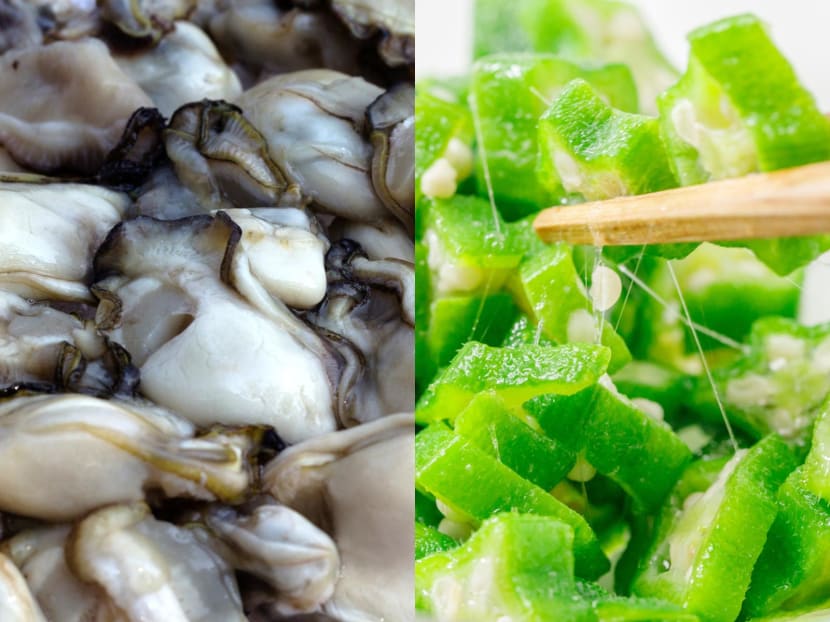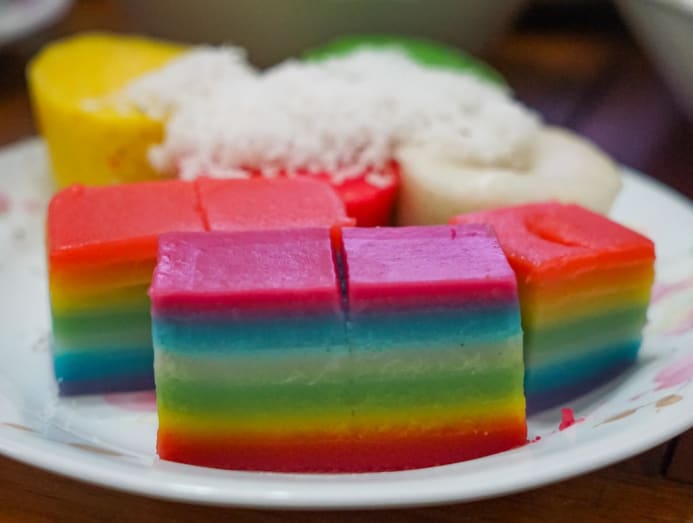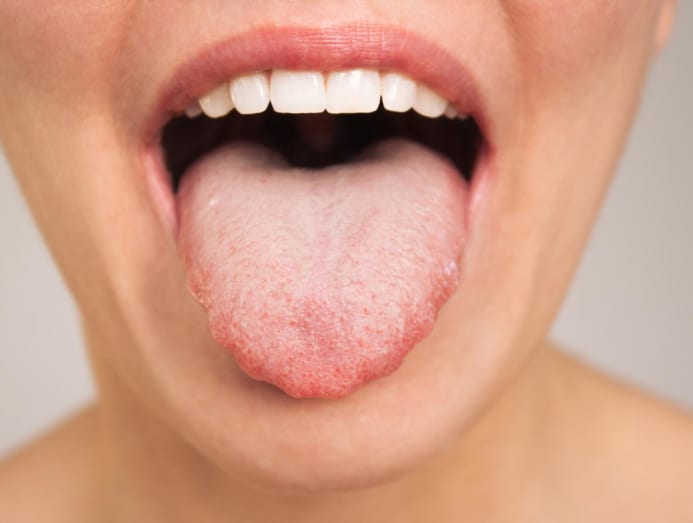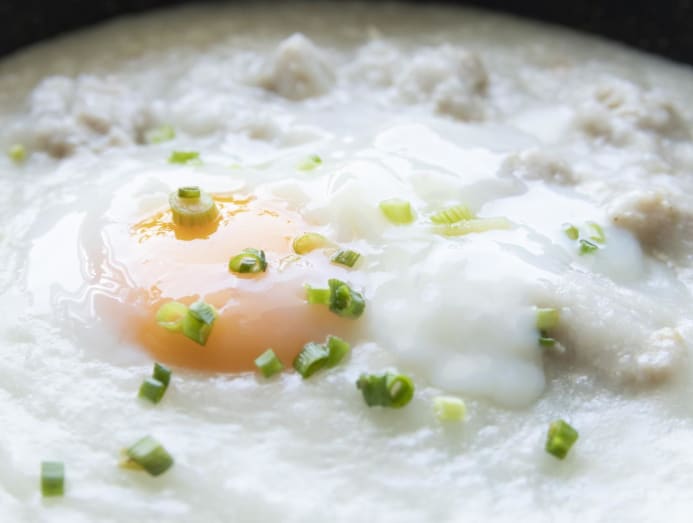Lady’s fingers, oysters, dried seaweed: Why do some people dislike slimy, mushy or dry foods?
Sometimes, it’s not a matter of being a fussy eater. It could be a sign of dementia or autism – and certain food textures can be overwhelming for these individuals.

Are you repelled by the slimy texture of raw oysters and lady's fingers? (Photos: iStock/Le bonheur Venita and flyingv43)

This audio is generated by an AI tool.
As a nation of food-loving people, you may feel a little befuddled when a friend or colleague (there's always one, isn't it?) announces they don’t ever – ever – touch certain foods because of their “icky” textures. Slippery lady’s fingers and raw oysters, the sticky tendrils of natto, chewy ondeh ondeh and tapioca pearls, gooey camembert and mushy durian pulp, to name a few.
Perhaps that is understandable, especially when the food’s texture is unexplored territory, like the 16 insect species that were recently approved for our consumption in Singapore. Will the whitegrub ooze or offer up a chewy resistance when you bite into it? How does the crunch of grasshopper legs feel in the mouth?
Texture certainly enhances the way we experience food. And boy, do we love a good crunch, a sound coded by evolution as it turns out. "Noisy fruit and vegetables signal a fresher product, and fresher products are likely to have retained more of their nutrients,” explained Charles Spence, a professor of experimental psychology at the University of Oxford in England.
And he has some findings in his 2005 study to back it up: People perceived potato chips as fresher when they heard loud crunching after biting into them. But the chips got a staler rating when the sound was less intense – even though everyone was biting into chips from the same package.

Evolution aside, food textures complete our enjoyment of food, wrote Sybil Kapoor, author of Sight Smell Touch Taste Sound A New Way To Cook. “It is our sense of touch that is vital for culinary enjoyment, from the moment we hold something with our hands to the final swallow. It allows us to savour the temperature, taste and flavour of food as well as the sound food makes as we eat”.
But what makes one man’s gastronomical joy another man’s Fear Factor? Why is congee considered a bowl of velvety, savoury comfort to someone but an absolute nightmare akin to vomit to another? We find out from the experts.
WHAT ARE SOME OF THE TEXTURES THAT PEOPLE TEND TO AVOID?
Can’t bear the slimy seaweed floating in your bowl of miso soup? Always avoiding the soft, mushy brie on the cheeseboard? You are not alone. “Aversions can vary widely among individuals and may be influenced by personal preferences, past experiences and sensory sensitivities,” said Mary-ann Chiam, the senior principal dietitian with Allium Healthcare.
Other than slimy and mushy textures, people with dry mouths may also find foods that are sticky, gelatinous or dry unbearable. “Having a dry mouth makes it harder to chew and masticate,” said Chiam.

“We need moisture, and good oral health and hygiene to masticate sticky, mushy or too-chewy textures,” she said. “The sensation of such foods sticking to the roof of the mouth will naturally cause these individuals to avoid eating these gag-inducing textures.”
What is surprising is that gritty, crunchy and fibrous foods also made the list. “Certain types of grains and beans, or poorly blended smoothies, can have a gritty texture that some find off-putting,” said Chiam. “While many enjoy crunchy foods, some individuals may find the texture of raw vegetables, nuts or certain snacks too intense.”
WHAT’S USUALLY CAUSING THE AVOIDANCE OF CERTAIN FOOD TEXTURES?
Again, evolution comes into play. “Textures like sliminess or mushiness can instinctively remind us of rotting or spoiled food, which our ancestors avoided for safety reasons," said Chiam. "This evolutionary trait helps us steer clear of potentially harmful substances."
If you’re a supertaster, that is, you’re born with more tastebuds, you could be physiologically more sensitive to a food’s mouthfeel, said Professor Linda Bartoshuk, a psychologist and Bushnell Professor of Food Science and Human Nutrition at the University of Florida. This makes you experience textures more intensely. For instance, you may find pulut hitam far too rich and creamy compared to a regular taster.

Sometimes, the cause of the aversion is hypersensitivity. “Heightened oral sensory sensitivity can make textures like slimy okra or chewy rice cakes feel overwhelming,” said Chiam. “Negative experiences, such as gagging or choking, can also create lasting aversions to these textures.”
You can't deny that what your family usually eats – or doesn't eat – plays a big part as well. “Childhood experiences, family preferences and societal norms play a significant role in shaping our comfort with various textures,” said Chiam. “Repeated exposure to certain textures, either positive or negative, can reinforce these preferences or aversions throughout life.”
Cultural differences are another reason. “Foods with certain textures may be more accepted in some cultures, while others find them off-putting,” she said, which brings to mind why some foreigners find our love for soft-boiled eggs disgusting, while some of us find blue cheese abhorrent.
COULD THERE BE HEALTH-RELATED CAUSES?
“For adults, the food aversions we see are usually in those with cognitive impairment such as dementia,” said Jaymie Chai, a principal speech therapist from Alexandra Hospital. “The aversions could be secondary to a diagnosis or some sort of discomfort that the patient is unable to communicate.”
The aforementioned avoidance of fibrous and crumbly textures, for instance, is often seen in the elderly, said Chai. “These are usually dementia patients and the reason for the aversion could be related to chewing function, cognition or preference.”

At times, the refusal to eat certain foods can be indicative of underlying sensory processing and psychological conditions, said Chiam, citing these potential issues:
- Sensory processing disorders: These individuals may be overly sensitive to sensory input, including food textures, making certain textures overwhelming or unpleasant.
- Autism spectrum disorder: They have aversions to specific textures as part of the broader sensory processing challenges often associated with autism.
- Avoidant/Restrictive food intake disorder: This eating disorder is characterised by avoiding certain foods due to their sensory characteristics, including texture.
- Anxiety and stress: High levels of anxiety or stress can make individuals more sensitive to sensory stimuli, including food textures. This can lead to stronger aversions or picky eating behaviours.
IS THERE A NEED TO LEARN TO ACCEPT MORE FOOD TEXTURES?
Yes, said Chai, if the aversion is affecting your nutrition. But other than that, overcoming and accepting various food textures can also “enhance social and cultural integration, fostering enjoyable dining experiences and expanding culinary horizons”, said Chiam.
“However, the need to overcome these aversions varies individually,” she said. “For those with sensory processing challenges or severe aversions, professional guidance can help manage and gradually introduce new textures in a supportive manner.”
Chai suggested checking with your child’s paediatrician about a structured programme called Sequential Oral Sensory Approach to Feeding (SOS). “For adults, we usually don’t ‘overcome’ the food aversion per se, but either modify the texture or replace the food with other foods or nutritional supplements.”
Speak with a dietitian if you think that your fussiness about certain food textures is a potential issue.







